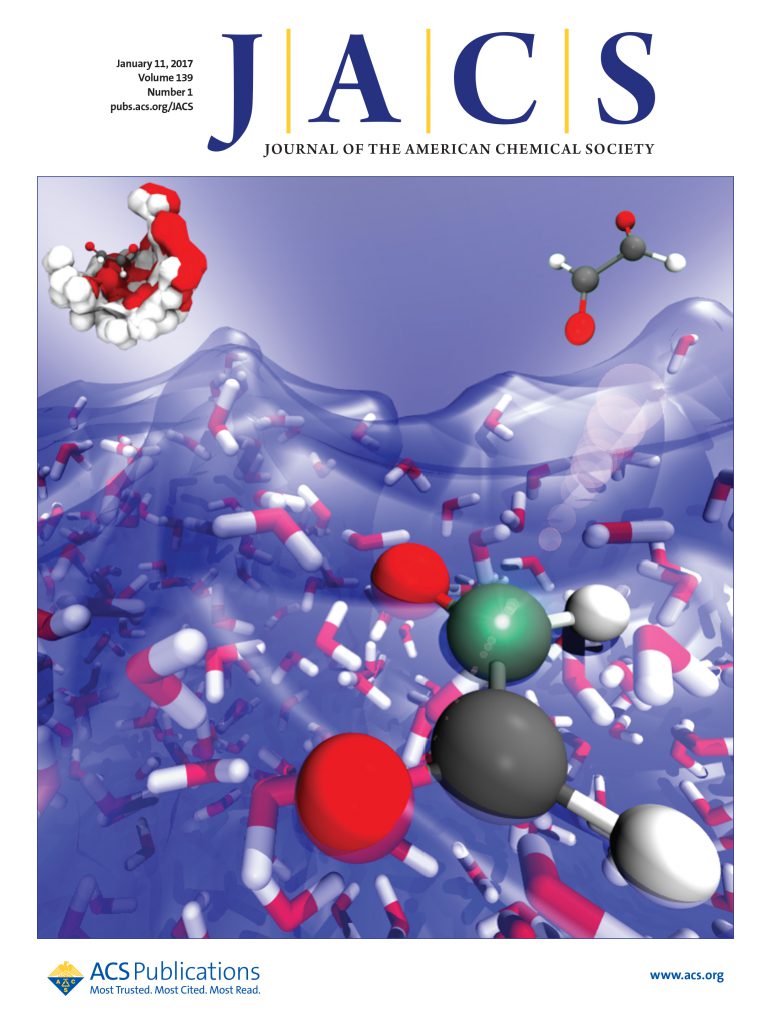Formyl Radical Generation from Methane Oxidation Promoted by the Superoxide Radical in Tungsten Oxide Cations WO4.
IF 14.4
1区 化学
Q1 CHEMISTRY, MULTIDISCIPLINARY
引用次数: 0
Abstract
The formyl radical (HCO•) is a critical intermediate species involved in atmospheric, combustion, interstellar, and catalysis chemistry. The complicated reaction networks of HCO• formation from a variety of substrates such as COx molecules as well as unsaturated hydrocarbons and their derivatives have been widely proposed. By contrast, the contribution of saturated hydrocarbons (e.g., methane) to HCO• generation remains largely elusive. Herein, we successfully identify that the metal oxide cluster cation, WO4+, that features a superoxide radical (O2-•) can activate three C-H bonds of methane and then directly oxidize methane to the HCO• radical at room temperature. This finding represents a sharp improvement in the field of direct methane oxidation to oxygenated compounds by metal oxide systems wherein selective activation of one, two, or four C-H bonds was generally involved. We propose that the presence of a superoxide radical is very effective to prevent the high-valent metal center from being reduced, which is thermodynamically and kinetically advantageous for direct oxidation of methane to a free HCO• radical. This work not only reports an unprecedented route for production of the HCO• radical but also provides convincing evidence to consider methane as an important source in constructing the reaction networks relevant with HCO• generation.氧化钨阳离子WO4中超氧自由基促进甲烷氧化生成甲酰自由基的研究。
甲酰自由基(HCO•)是参与大气化学、燃烧化学、星际化学和催化化学的重要中间体。各种底物如COx分子以及不饱和烃及其衍生物生成HCO•的复杂反应网络已被广泛提出。相比之下,饱和碳氢化合物(如甲烷)对HCO生成的贡献在很大程度上仍然难以捉摸。在此,我们成功地确定了具有超氧自由基(O2-•)的金属氧化物簇阳离子WO4+可以激活甲烷的三个C-H键,然后在室温下直接将甲烷氧化为HCO•自由基。这一发现代表了金属氧化物系统在甲烷直接氧化为含氧化合物领域的一个重大进步,其中通常涉及一个、两个或四个碳氢键的选择性活化。我们认为,超氧自由基的存在对防止高价金属中心被还原非常有效,这在热力学和动力学上有利于甲烷直接氧化为游离HCO•自由基。这项工作不仅报道了一种前所未有的HCO•自由基的生成途径,而且提供了令人信服的证据,证明甲烷是构建与HCO•生成相关的反应网络的重要来源。
本文章由计算机程序翻译,如有差异,请以英文原文为准。
求助全文
约1分钟内获得全文
求助全文
来源期刊
CiteScore
24.40
自引率
6.00%
发文量
2398
审稿时长
1.6 months
期刊介绍:
The flagship journal of the American Chemical Society, known as the Journal of the American Chemical Society (JACS), has been a prestigious publication since its establishment in 1879. It holds a preeminent position in the field of chemistry and related interdisciplinary sciences. JACS is committed to disseminating cutting-edge research papers, covering a wide range of topics, and encompasses approximately 19,000 pages of Articles, Communications, and Perspectives annually. With a weekly publication frequency, JACS plays a vital role in advancing the field of chemistry by providing essential research.

 求助内容:
求助内容: 应助结果提醒方式:
应助结果提醒方式:


